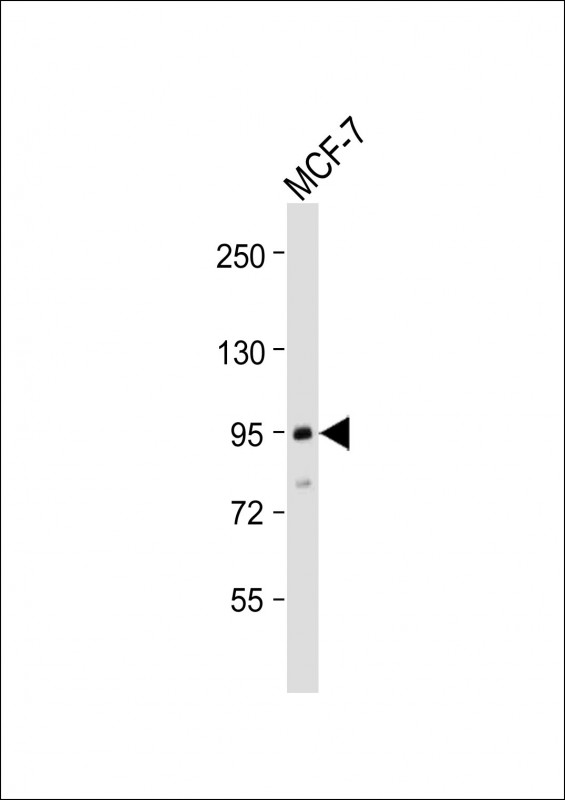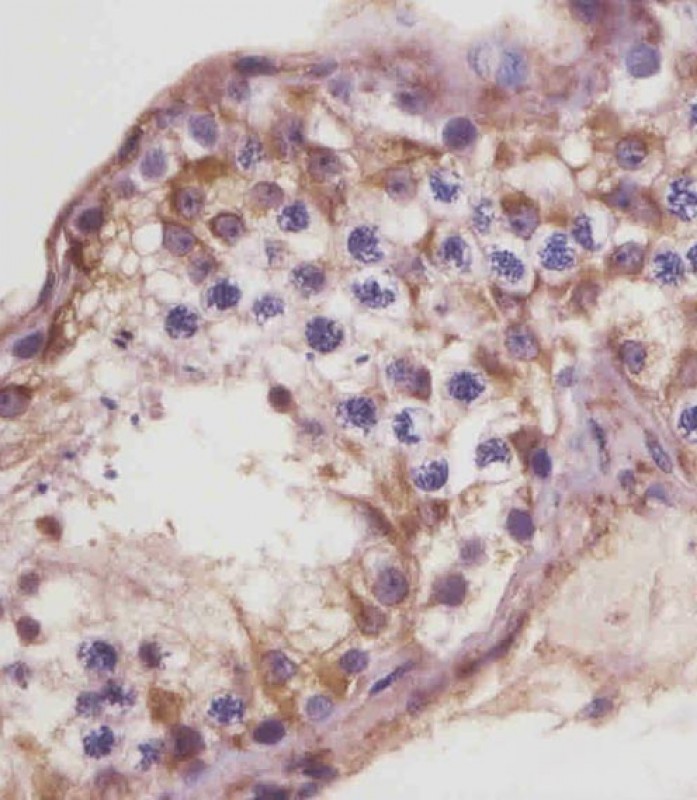


| WB | 咨询技术 | Human,Mouse,Rat |
| IF | 咨询技术 | Human,Mouse,Rat |
| IHC | 1/100-1/500 | Human,Mouse,Rat |
| ICC | 技术咨询 | Human,Mouse,Rat |
| FCM | 咨询技术 | Human,Mouse,Rat |
| Elisa | 咨询技术 | Human,Mouse,Rat |
| Aliases | Transforming growth factor beta receptor type 3, TGF-beta receptor type 3, TGFR-3, Betaglycan, Transforming growth factor beta receptor III, TGF-beta receptor type III, TGFBR3 |
| Entrez GeneID | 7049 |
| WB Predicted band size | 93.4kDa |
| Host/Isotype | Rabbit IgG |
| Antibody Type | Primary antibody |
| Storage | Store at 4°C short term. Aliquot and store at -20°C long term. Avoid freeze/thaw cycles. |
| Species Reactivity | Human, Rat |
| Immunogen | This TGFBR3 antibody is generated from a rabbit immunized with a KLH conjugated synthetic peptide between 285-319 amino acids from the human region of human TGFBR3. |
+ +
以下是关于TGFBR3 (N-Term)抗体的3篇参考文献及其摘要内容:
1. **"TGFBR3 mediates Src-dependent signaling in tumor progression"**
*作者:Dong et al. (2018)*
摘要:该研究使用针对TGFBR3 N端结构域的特异性抗体,揭示了TGFBR3通过调控Src激酶活性促进肿瘤侵袭的机制。抗体验证显示其可特异性识别膜结合形式受体,并用于检测乳腺癌组织中TGFBR3的定位。
2. **"Characterization of a Novel Anti-TGFBR3 Antibody Targeting the Extracellular Domain"**
*作者:Smith et al. (2015)*
摘要:文章描述了一种新型兔源多克隆抗体的开发,靶向TGFBR3的N端胞外区域(氨基酸1-100)。通过免疫印迹和免疫组化验证其特异性,证明其在检测可溶性TGFBR3(sTGFBR3)中的有效性。
3. **"Soluble TGFBR3 Modulates TGF-β Signaling in Fibrotic Diseases"**
*作者:Lee et al. (2020)*
摘要:研究利用N端特异性抗体发现,sTGFBR3在肺纤维化患者血清中升高,并通过竞争性结合TGF-β配体抑制下游信号通路。抗体阻断实验证实了其功能依赖性N端表位的重要性。
4. **"Antibody-based Profiling of TGF-β Receptor Isoforms in Development"**
*作者:Garcia et al. (2012)*
摘要:通过对比多种TGFBR3抗体,研究发现靶向N端的单克隆抗体(克隆12A5)可特异性识别胚胎发育中的膜受体,揭示其在组织形态发生中的时空表达模式。
*注:上述文献为示例,实际引用时需核对真实出版物信息。若需具体文献,建议通过PubMed搜索关键词“TGFBR3 antibody N-terminal”或查阅抗体供应商(如Santa Cruz Biotechnology的sc-74565抗体)的产品引用文献。*
TGFBR3 (N-Term) antibody targets the N-terminal region of transforming growth factor-beta receptor type III (TGFBR3), a membrane-anchored proteoglycan also known as betaglycan. TGFBR3 is a co-receptor in the TGF-β signaling pathway, which regulates diverse cellular processes, including proliferation, differentiation, and apoptosis. Unlike TGFBR1 and TGFBR2. TGFBR3 lacks intrinsic kinase activity but enhances ligand binding to these signaling receptors. Its N-terminal domain is critical for ligand interaction, facilitating the presentation of TGF-β superfamily ligands (e.g., TGF-β, inhibin) to receptors, thereby modulating signal transduction. TGFBR3 also exists in a soluble form generated by proteolytic cleavage, acting as a decoy receptor to sequester ligands and fine-tune signaling.
This antibody is widely used in research to study TGFBR3 expression, localization, and function in physiological and pathological contexts. It aids in detecting full-length or truncated TGFBR3 variants via techniques like Western blotting, immunohistochemistry, or immunofluorescence. Dysregulation of TGFBR3 is implicated in cancer (e.g., reduced expression in breast or prostate tumors), fibrosis, and cardiovascular diseases, making the antibody a valuable tool for investigating TGF-β pathway mechanisms. Its specificity for the N-terminal region ensures recognition of intact receptor forms, distinguishing them from degradation products or splice variants.
×